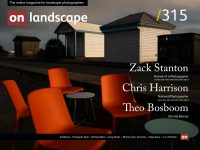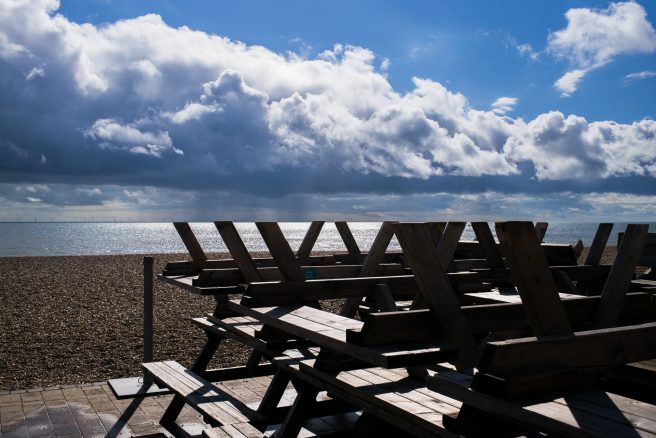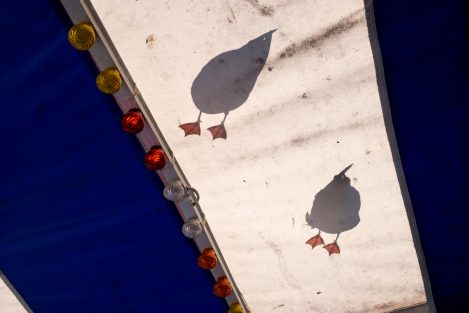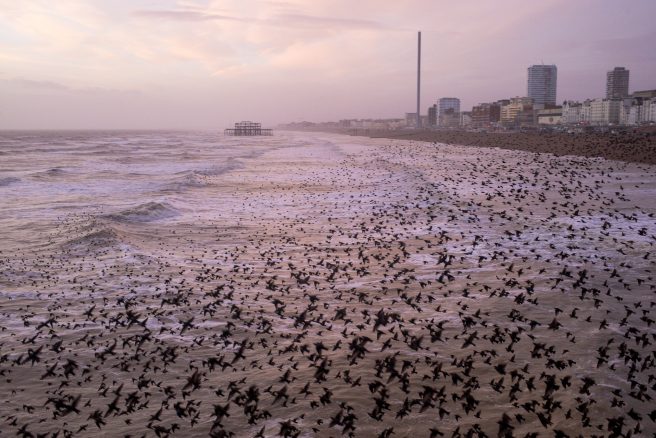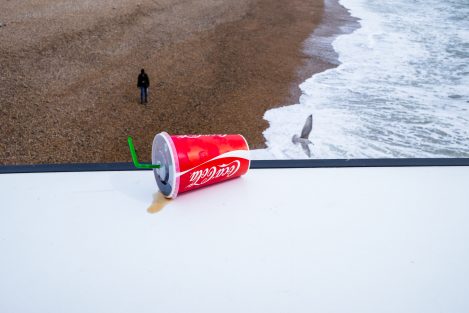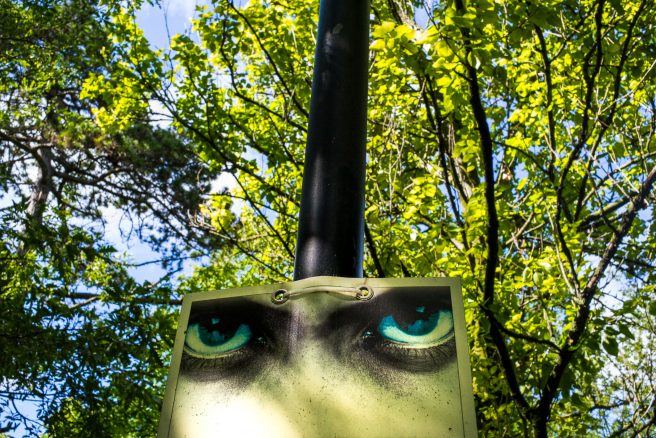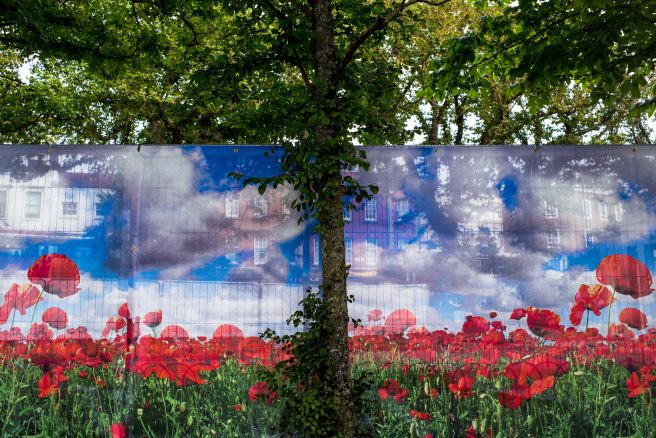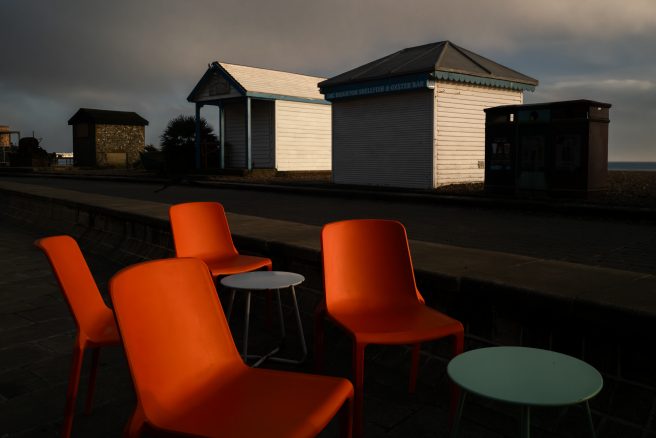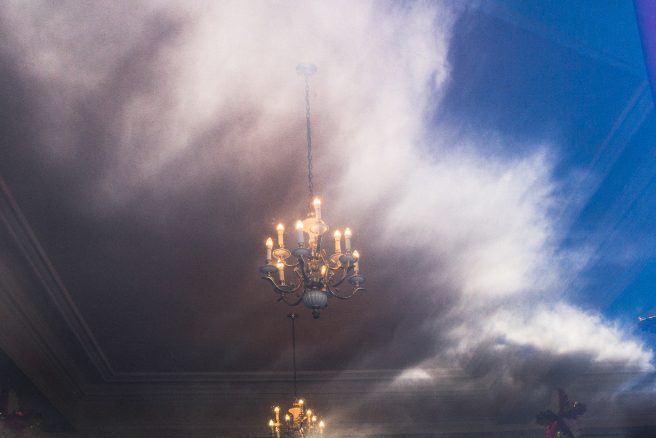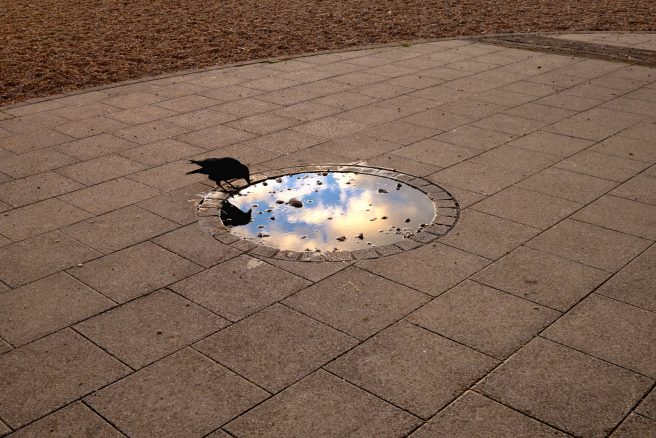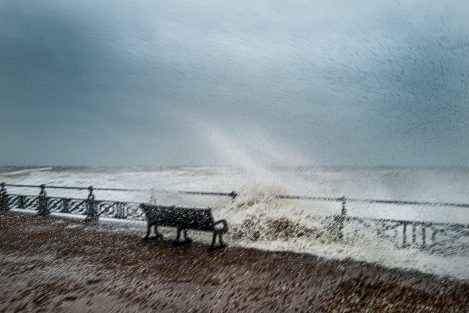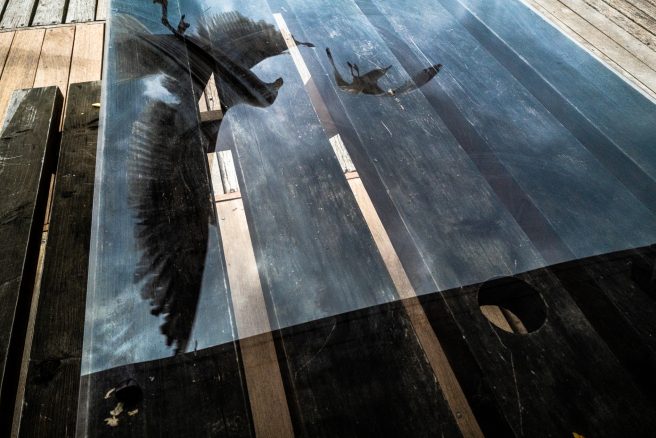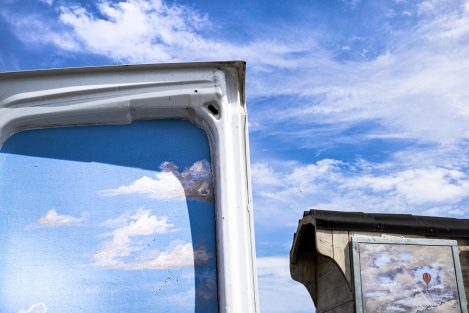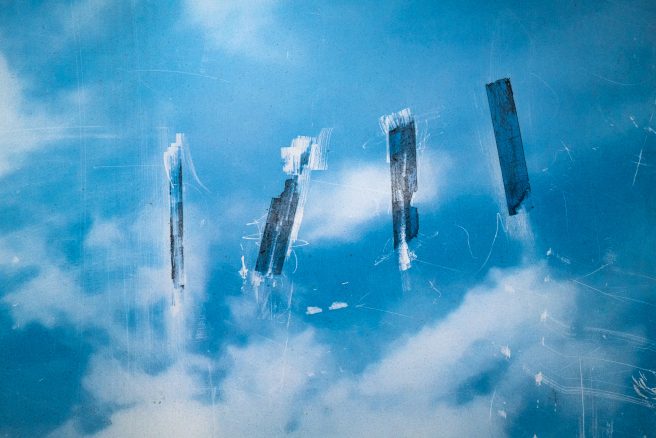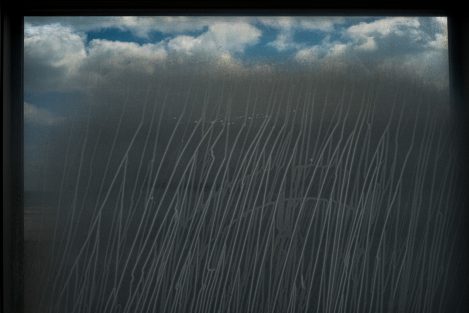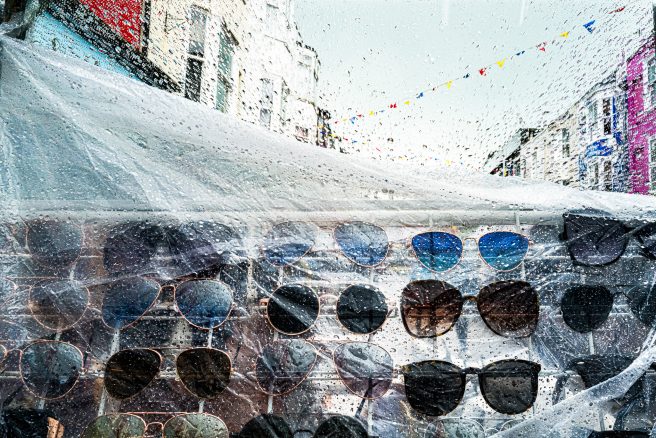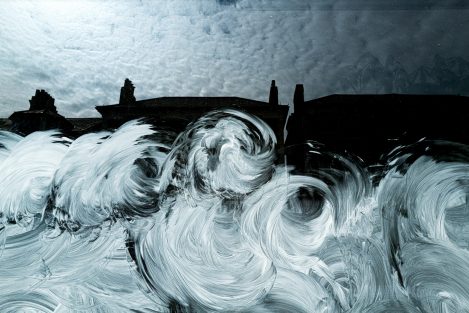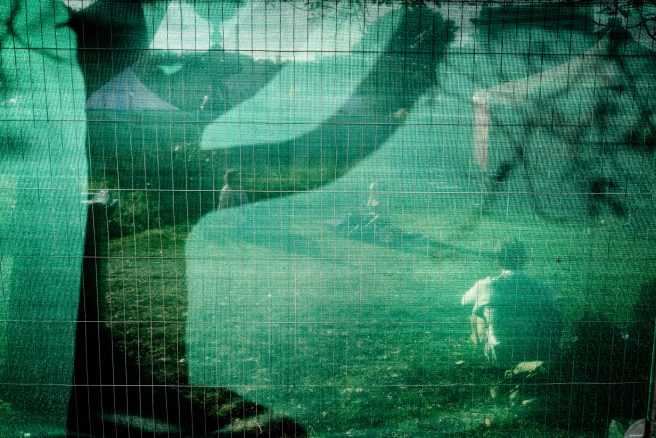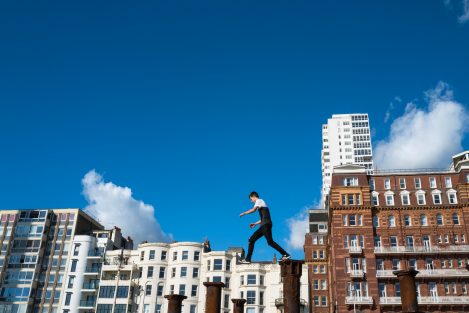Featured Photographer

Chris Harrison
Chris Harrison, a brand consultant and street photographer based in Brighton, UK, studied graphic design and photography in the late 1980s. He worked at Saatchi & Saatchi before setting up his own design studio in 2003. In 2016, he began a long-term project exploring Brighton's streets and beach, resulting in his book, "Sideshow," which he self-published in January 2024. The 450-copy edition sold out by May 2024.

Michéla Griffith
In 2012 I paused by my local river and everything changed. I’ve moved away from what many expect photographs to be: my images deconstruct the literal and reimagine the subjective, reflecting the curiosity that water has inspired in my practice. Water has been my conduit: it has sharpened my vision, given me permission to experiment and continues to introduce me to new ways of seeing.
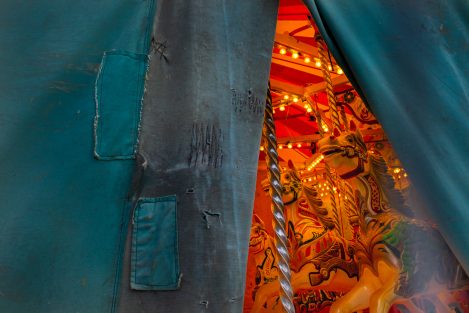
Whatever labels we prefix photography with, it is a fluid form of art and craft that largely follows the curiosity of the person behind the lens. Just as the countryside evolves over time and with weather, urban street scenes are in flux, shaped by changes in the built fabric, the movement of people, the play of light, and the unfolding of everyday life. Street photography invites us to see the city as a living organism, a landscape of opportunity with its own rhythms and stories.
In this issue, we feature Chris Harrison. While he always takes his camera with him on his travels, the majority of his work is made in his home city of Brighton, often from the same short section of the seafront. As you will see, the mix of Chris’ curiosity and the dynamics of the city mean that this is far from being a constraint.
Would you like to start by telling readers a little about yourself – where you grew up, and what your early interests were?
Originally, I’m from a small, rural village nestled right on the edge of the Lincolnshire Wolds. I grew up there in the 1970s and 80s. From an early age, art and creativity were something I felt very drawn to. I’m not sure where that came from because nobody in my family had any interest in art!
Like many people from my generation, the 80s indie music scene became a source of inspiration. Some of my earliest memories of taking an interest in photography came from the sleeves of the LPs in my small record collection. Two names stand out from that period: Brian Griffin's photographs of Echo & The Bunnymen and the beautiful design and art direction that Peter Saville produced for New Order.
You credit one image in particular with opening your eyes to photography? Did this contribute to your choice of college studies, or had you already decided on a course?
My interest in art and design led me to apply to study graphic design at Lincolnshire College of Art & Design in the late 80s. I wasn’t the most academic kid, but I managed to just about scrape the 4 O levels I would need to go to art college.
I received a letter with a list of materials I’d need to get started at college. One of the suggestions on the list was to subscribe to a photography magazine. This kind of confused me because I’d signed up for a graphic design course – photography wasn’t really on my radar. At that time, I didn’t realise that graphic design and photography go hand in hand.
The photography magazine arrived, I opened it, and an image of a Great Dane, Chihuahua and a woman wearing long boots had me mesmerised. I had so many questions, “what am I looking at?”, “who made this?”, “why was this made?”, “who sees the world in this strange way?”. The magazine's main feature for that issue was none other than Elliott Erwitt. That’s when things really changed for me. My eyes became fully open to photography and its hypnotic quality, its ability to hold someone's attention and tickle their heart. It was love at first sight.
At art college, I felt the magic of printing my first photo. I remember being so blown away by the darkroom process that one of the photography department technicians laughingly told me to calm down! I’m not sure if I was high from the developing chemicals or on a natural high from finding something that I loved being a part of. It was, and still is, a magical and sometimes euphoric experience.
However, despite the strong connection I initially felt to photography, I didn’t have the courage to make it a bigger part of my life. After college, I needed to earn a living quickly. Full-time photography didn’t feel like the right choice for me, so I took the safe option and pursued my career as a designer.
What role did photography subsequently play for you? What prompted you to pick up the camera again after a break?
After I left art college, I kept my hand in with photography during the 1990s, occasionally being immersed in it (using my bathroom as a darkroom and printing my own work) while other times my cameras have gathered dust or been sold to pay for other things.
In 2016, after a 15-year hiatus and a chance visit to Arles Photo Festival, I reconnected with photography again. I saw an exhibition in Arles about the New York School of Photography from the 1950s – a collective known for candid street photography. Influential figures like Sid Grossman, Harold Feinstein, and Leon Levinstein captured raw, unposed moments of urban life.
Their work emphasised emotion and spontaneity, and I was taken right back to the original excitement of seeing Elliott Erwitt’s ‘Great Dane, Chihuahua, Legs and Boots’ for the first time. I asked myself, “Why did you stop? Why aren’t you doing this anymore?” I made a decision to dive back into photography and commit to it. I’m still plugging away.
Who (photographers, artists or individuals) or what has most inspired you, or driven you forward in your development as a photographer – either in your early days or subsequently?
There are so many photographers who have greatly inspired me. As I’ve said, my first introduction to photography was with Elliott Erwitt.
Some of the earlier inspirations were Don McCullin and Steve McCurry. I bought a copy of The Shipping Forecast by Mark Power when it was first released in 1996, and that also really planted a seed for how a bigger idea could be handled in an original way.
In the year 2000, I lived and worked in Sydney and became familiar with the work of Trent Parke and Narelle Autio – their work is still a huge inspiration for me today.
A few years ago, I discovered the work of Jeff Jacobson, who made a mesmerising photo book called Melting Point, which is probably one of my all-time favourites, and became an inspiration for me to make my own book, ‘Sideshow’.
I also love Harry Gruyaert’s work along the off-season parts of coastal Belgium. I mentioned Brian Griffin's work for musicians earlier. I love his inventiveness and how he plays with surrealism, which is something I’m also naturally drawn to.
Going off on a bit of a tangent, there are artists who straddle the world of graphic design and photography. Two people who fall into that space are Storm Thorgerson, who was responsible for most of Pink Floyd's album artwork, and Jean Paul Goude, who created lots of wacky campaigns for musicians and fashion brands. I haven’t even mentioned Joel Meyerowitz, Luigi Ghirri, Saul Leiter, and Henri Cartier Bresson. I could go on and on!
You talk about curiosity and spontaneity being important to your enjoyment but mostly work the same stretch of seafront. This constraint of place is a good way of encouraging experimentation, and fostering creativity?
Photography can happen anywhere, and often, the most interesting work comes from places we already know well. For me, that’s Brighton. It’s not about how far you travel, but more about seeing the every day with a sense of curiosity, letting things surprise you that you might usually pass by without a second thought.
I’ve been working the same stretch of Brighton seafront for ages, and it can feel limiting at first like you’ve seen it all before, and there’s nothing new to discover. But that feeling, the constraint of the same spot, actually pushes you to look harder, to dig deeper and start seeing the ordinary in ways you might not expect. It forces you to look past the obvious and question how you're seeing it.
While exotic locations might seem like they’re overflowing with inspiration, I’ve found that real creativity tends to spark when you stay put and commit to seeing what’s right in front of you – whether that’s just down the street or around the corner from home. It’s not easy, though. It takes patience. There’s this frustration in the beginning, where you feel like you’ve already taken every possible shot, and there’s nothing new to capture. But if you stick with it and keep that curiosity alive, something shifts.
Working within the constraint of a specific place, like Brighton’s seafront for me, forces me to slow down, to stop looking for something dramatic and instead find the subtle details that usually go unnoticed. It’s a challenge, but that’s what makes it interesting. The more you pay attention, the more you realise that even the most familiar places can be full of surprises.
So yeah, that limitation of staying in one spot can actually be a gift. It makes me see beyond the surface, finding magic in the everyday things I might’ve missed otherwise. And sometimes, that’s where the best creativity happens – right there in the familiar, waiting for you to look at it differently.
You carry your camera wherever you go. Has this resulted in any unexpected opportunities? Perhaps we can tie this in with asking you to choose 2 or 3 photographs from your own portfoliotell us a little about your experience of making them.
17:06 – 17th March 2023
This is almost one of the most mundane and ordinary scenes that you will see in Brighton, and I have walked past these huts and the orange chairs hundreds of times. It’s the end of the day and spring will officially start in three days' time. The sun is low enough to make the huts look interesting, but it’s the chairs that are transformed by the late winter light.
13:08 – 20th December 2019
This photograph was taken on the way home. I’d been shooting for a few hours and was running to catch the bus. As I crossed the road, I glanced up into a hotel room window and saw this chandelier hanging from the clouds. Quite mysterious and a bit magical. There’s a quiet simplicity to the shot that I really like.
16:10 – 18th November 2019
I was struck by how much the reflected clouds in this shallow circular puddle resembled a picture of Earth. A curious crow hopped over to take a look, too; it felt like there wasn’t much that needed to be done to make the shot, apart from being patient.
Can you give readers a brief insight into your set up – from photographic equipment through processing to printing? Which parts of the workflow especially interest you and where do you feel you can make the most difference to the end result?
My setup, if you can call it that, is very simple. Just me, my Leica Q2, and whatever I find in the street. My journey with Leica began after attending a Bruce Gilden workshop at the Leica Store in Mayfair, London. I borrowed an M240 from the store for a couple of days and instantly fell in love with it. It felt intuitive, and the image quality was a significant leap from what I’d experienced with other digital cameras. Hooked from that moment, I soon bought a pre-owned M262, and a few years later, took the plunge and bought a pre-owned Q2, also from the Leica Store in Mayfair.
I've been using the Q2 almost exclusively for nearly four years now. It's far from mint condition – it's well-used, and it shows. But cameras are made to be used, and my Q2 has weathered rain and salty sea air many times without any loss in image quality or mechanical performance. What I love most is its simplicity and design. It’s not overloaded with unnecessary features; it’s fast, responsive, and compact, making it easy to carry for hours without feeling cumbersome.
My editing process is intentionally straightforward and efficient. After spending a few hours out on the streets of Brighton – anywhere from 2 to 5 hours, often covering several kilometres – I download all the photos from my camera as soon as I get home. This has become a bit of a ritual for me. Walking through Brighton, capturing candid moments, is where the heart of my work is, and when I return, I want the post-shoot process to be as simple as possible.
For all of my archiving, cataloging, and editing, I rely on Adobe Lightroom. It’s a tool that allows me to keep everything organised and in one place, without unnecessary complications. Lightroom’s functionality fits with my preference for simplicity, making it easier for me to manage my growing library of images.
Occasionally, when I come across a photo that stands out – one I feel has potential for a future book project or that I might want to sell as a print – I’ll take the time to print it. But even then, my editing process remains minimal. I don’t believe in heavy manipulation or drastic alterations. My approach to editing is all about preserving the authenticity of the image. I’ll make minor adjustments, usually just correcting or enhancing the colour slightly, performing minimal cropping, and possibly tweaking the contrast. That’s about the extent of my edits. I want the image to stay as true to the moment it was captured as possible.
For me, the goal is to spend as little time as possible sitting in front of a computer. That’s why I keep the editing side of things really simple and streamlined. I’d rather be out in the streets, with my camera, where the magic happens.
You’ve described the street as being “a set of ingredients in flux, where the challenge is to make something interesting out of it”. Of these is light especially important to you?
Yes, light’s really important to me, but it’s just one piece of a much bigger puzzle, really. When I say the street is “a set of ingredients in flux,” I’m talking about how everything is constantly shifting – the people, the movement, the mood, and of course, the light. Nothing stays still, it’s all changing, so you’ve got to be tuned in to all of it. Especially in street photography, where you’ve got no control over any of it, you’re just reacting to what’s happening around you.
Light can completely change a scene. It can take something totally ordinary and turn it into something a bit special – a shadow falling just right, light hitting someone’s face, or that warm glow you get on a wet street as the sun goes down. But even though light is key, I wouldn’t say I obsess over it. I work with whatever’s there at the time. I’m more interested in the energy of the moment, in what’s happening in front of me, rather than hanging around for perfect lighting.
You can’t really wait for the ideal light in street photography. You’ve just got to make the most of what’s in front of you. And I think that’s where creativity comes in – being able to see something interesting, even when the light’s not what you’d ideally want. It’s not about perfection, it’s about working with what you’ve got and still finding those moments. For me, it’s about being ready for something unexpected to happen. That’s the real challenge – not waiting for the light to be right but being ready to respond when it all comes together in a way you weren’t expecting.
How valuable has your experience of working in a design agency been in developing your ability to appraise your own photos and portfolios, and decide what works?
Working in a design agency has really shaped how I see and evaluate my own photos and portfolios. In design, you’re always making decisions about what stays in and what gets cut, figuring out what works visually and what doesn’t. It’s a constant process of refining, editing, and simplifying until you end up with something that communicates clearly. That discipline has naturally carried over into my photography.
Being able to self-edit is so important. Just like in design, I’ve come to realise that sometimes less is actually more. Not every photo needs to be a standout; some of them can just be good without needing to steal the show.
I think the design mindset has also taught me not to get too attached to any single image. Sometimes, you’ve got to be a bit ruthless, especially when you’re putting together a portfolio. It’s not just about picking out the individual shots you love; it’s about the overall narrative and coherence of the whole thing. It’s a bit of a balancing act, really. You want each image to play its part, but you also want to see how they fit together. Sometimes I find myself wondering if a photo really adds to the story or if it’s just there because I like it. It’s all part of the process, I guess, trying to find that sweet spot between personal attachment and the bigger picture.
Have you had the opportunity to exhibit your ‘Sideshow’ project? What reactions have the images prompted? It’s always good to show people something they think they know well in a different light.
I haven’t exhibited ‘Sideshow’ in its entirety. But I have had a small involvement in group shows, which have mainly been street photo festivals in Sydney, Rome, Brussels, Gothenburg, Miami and LA. I did have a small show at Finn Hopson’s Brighton photography gallery on Brighton seafront in 2022. Exhibiting is something I’d love to do more of. It's another discipline to curate a show and think through how the images will work together in a physical space.
Of the images that have been exhibited, I’m always surprised by people's reactions. I guess we spend so much time looking at our own images they can become so familiar that one wonders whether anyone else would find them interesting. So, seeing people puzzling over an image of mine in real life is quite a thrill. The images that tend towards an element of optical illusion tend to draw people in – they’re trying to decode the image or work out what's going on. That’s quite fun to watch. I guess there are also images that I feel very fond of that others don’t quite understand, and that’s also quite interesting to observe.
Overall, seeing the work printed large and displayed in a physical space does shift our relationship to the image. It becomes an object that exists in the real world rather than on a computer screen or viewed on Instagram through a phone.
What role do books play for you? Have any especially inspired you, and do you have plans to make more?
Books have been incredibly important to me. In fact, they don’t even need to be monographs or specific bodies of work for me to get excited. I mentioned earlier that my first job was in the ad agency Saatchi & Saatchi. One of my tasks in the early part of my career was to trawl through stock photography catalogues, looking for images to use in campaigns and brochures we were working on. Depending on the library, there could be some wonderful examples of great photographic work. Sure, most of it was commercial work for commercial use, but there were a lot of beautifully crafted images.
Looking back, I think this experience was invaluable to how I work today. I must have spent thousands of hours looking through hundreds of thousands of images, sometimes for days and days at a time. Nine to five, week in and week out. Although I didn’t realise it at the time, my mind was logging away all of these images, regardless of how successfully I’d be able to recall them. I think this gave me a sense of what works in an image because, again, I was evaluating the images for how we could use them in a campaign – too moody, too busy, too bright, too bland, etc., etc.
In addition to trawling through photo books for my day job, I’d also obsess over “real” photo books on the weekends. There was an art bookshop on Charing Cross Road called Zwemmer’s, which sadly doesn’t exist anymore. After walking around London for several hours with my camera, I’d go for a browse in Zwemmer’s. I couldn’t afford to spend lots of money on books, but some of the ones I did pick up from Zwemmer’s included a photo book by Richard Gere called ‘Pilgrim’. It’s a beautiful visual diary of his travels in Tibetan Buddhist communities and monasteries. I mentioned Mark Power’s Shipping Forecast’ earlier, which was another purchase from Zwemmer’s.
I guess I was just bumbling along looking for inspiration back then, because I bought a copy of ‘Photographic Notes: Everything is Important - Nothing is Important’, by Christian Vogt who was unknown to me at the time. He’s a Swiss photographer whose work I still really like. He has a unique way of exploring how to see things, playing with perception and time. His work is minimalist and thought-provoking. I had a period of trying to copy him very badly!
How do you feel that your photography has evolved, and where would you like to take it? Do you have any particular projects or ambitions for the future?
I think I spent many years with an idea in my head of the types of photos I wanted to make, but there was a large gap in my ability to either spot those photos or execute them in a way that I felt happy with.
I think I’ve made some images that do meet the internal vision of what I’m trying to achieve, but only a small number, really. So, in terms of evolution, I’d say my abilities have occasionally met with my idea for what I’m trying to achieve. And that does feel like some sort of progress.
In terms of where it goes from here, well, that’s a very big question mark if I’m being honest. I’ve invested 7-8 years in ‘Sideshow’ as a project, and I’m feeling a little adrift in what to do next. While that’s not the most comfortable place to be, I’m kind of OK with it, too. I know myself well enough to know that this is a bit of a cooling off period, and it (hopefully!) won’t take me long to formulate a new idea that I can work with and explore. I don’t feel quite done with Brighton just yet; I think there are other ways to approach it as a subject or a backdrop. I’ve got a few very vague ideas knocking around, nothing concrete, but something will emerge.
We all start off thinking that our photography is about place, subject, season… only at some point to realise that we are intrinsically part of it in what we respond to, and what we choose to show. What have you discovered about yourself through photography?
Through photography, I’ve realised just how much of myself is wrapped up in the way I see things. At first, I thought it was all about capturing the subject, the place, the season – like that was the whole point. But the more I’ve gone on, the more I’ve found it’s really about what pulls at me, even if I can’t fully explain why. It’s about the moments that resonate, the ones that feel right in some way.
There's a certain kind of joy in that process, in letting yourself be drawn to things without overthinking it. There’s a quote I love by Chögyam Trungpa, who was a Tibetan Buddhist Master. It’s a small part of a longer quote where he’s talking about how meditation can shape you – he says, "let the world tickle your heart". I think that's kind of what keeps me going – the simple joy of seeing something that does that sparks something in me. It’s not always obvious at first, but there's this feeling when I know I’ve captured it.
What I’ve also realised is that I’m doing this for myself, really. Photography’s become this way of figuring out how I view the world, but it’s not always clear, and that’s fine. There’s a certain amount of uncertainty in it, and I’ve come to appreciate that. I don’t always know where I’m going with it, and it’s more of a personal journey than anything else – one of discovery, really. I try to worry less about getting it “right” and just let it unfold, see what comes out. That’s what makes it meaningful to me.
If you had to take a break from all things photographic for a week, what would you end up doing? What other hobbies or interests do you have?
Tough question! Honestly, I can’t really imagine taking a week off and not taking my camera with me. If I was absolutely forced to do something different for a week, it would probably involve some sort of walking, scenery and hills. I love that, although I don’t do it often enough these days. I’ve been meditating for several years, so it could be a retreat of some sort, the kind where you leave your phone at home and just switch off for a whole week. That’s kind of bliss really.
For those who would love to experiment with street photography but are nervous about photographing around other people, and their potential reactions, what advice would you give them?
Well, I’d immediately say that street photography doesn’t have to involve taking pictures of other people; in fact it doesn’t even need to be done in or on a street. For anyone who wants to try out photography, or anything creative for that matter, then just jump straight in and do it.
I’ve read a fair few books written by artists who talk about their process and being creative. One of the best I’ve read is by Michael Craig-Martin, a book called ‘On being an artist’. His advice for anyone wanting to make a start with art or creativity is to simply START! He advocates for not needing to know what you're doing at first, nothing needs to be pinned down, and there doesn't need to be any concrete sense of certainty about where you’re going or what you’re aiming to achieve. Just let it unfold. Let that be the reason why you’d want to start any creative project – to see where it takes you. So that would be my advice, just start.
Although I discovered my love for photography at an early age, I spent way too many years not really getting started. I would kid myself that I’d start when I was less busy, had more time, knew what I was trying to say, had a project all worked out in advance. It really just doesn’t work that way. The conditions will never be perfect – you just have to commit to giving it a go.
And finally, is there someone whose photography you enjoy – perhaps someone that we may not have come across - and whose work you think we should feature in a future issue? They can be amateur or professional. Please include a link to their website or social media, as appropriate.
Yasuhiro Ogawa, a wonderful photographer from Japan - Instagram and website.
Thanks Chris, it will be good to see how your ideas take shape over time. I hope that our conversation will have encouraged a few readers to re-appraise what possibilities lie in their home towns and cities.
You can see more of Chris’ photography on his website.

